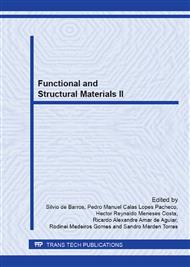[1]
J. F. Berthet, I. Yurtdas, Y. Delmas and A. Li: International Journal of Adhesion & Adhesives Vol.31 (2011), pp.75-83.
Google Scholar
[2]
H. T. Nguyen and S. E. Kim: Journal of Constructional Steel Research Vol. 65 (2009), pp.1909-1920.
Google Scholar
[3]
C. Xu, K. Sugiura, C. Wu and Q. Su : Journal of Constructional Steel Research Vol.72 (2012), pp.84-96.
Google Scholar
[4]
D. Xue, Y. Liu, Z. Yu and J. He: Journal of Constructional Steel Research Vol. 74 ( 2012), pp.1-7.
Google Scholar
[5]
L. Giachetti, S. Grandini, P. Calamai, G. Fantini and D.S. Russo: Journal of dentistry Vol.37 (2012), pp.638-642.
Google Scholar
[6]
E. Nagas, O. Uyanik, V. Durmaz and Z. C. Cehreli: International Endodontic Journal Vol.44 (2011), pp.950-955.
Google Scholar
[7]
K. Mastoras, L. Vasiliadis, E. Koulaouzidou and C. Gogos:. Journal of Endodontics Vol. 38 (2012), pp.510-514.
DOI: 10.1016/j.joen.2011.12.039
Google Scholar
[8]
G. Lin, P.H. Geubelle and N.R. Sottos: International Journal of Solids and Structures Vol. 38 (2001), pp.8547-8562.
Google Scholar
[9]
N. Chandra and H. Ghonem: Composites Part A––Applied Science and Manufacturing Vol. 32 (2001), pp.575-584.
Google Scholar
[10]
N. Chandra, H. Li, C. Shet and H. Ghonem: International Journal of Solids and Structures Vol. 39 (2002), pp.2827-2855.
Google Scholar
[11]
G. Alfano and E. Sacco: International Journal for Numerical Methods in Engineering Vol. 65 (2006), pp.542-582.
Google Scholar
[12]
J.-H. You, W. Lutz, H. Gerger, A. Siddiq, A. Brendel, C. Höschen and S. Schmauder: International Journal of Solids and Structures Vol. 46 (2009), pp.4277-4286.
DOI: 10.1016/j.ijsolstr.2009.08.021
Google Scholar
[13]
L. Gornet, H. Ijaz and D.D.R. Cartié: International Journal of Solids and Structures Vol. 38 (2010), pp.8547-8562.
Google Scholar
[14]
M. D. Banea and L. F. M. Silva: The Journal of Adhesion Vol. 85 (2009), pp.261-285.
Google Scholar
[15]
O. Allix and P Ladèveze: Composite Structures Vol. 22 (1992), p.235–242.
Google Scholar
[16]
N. Valoroso and L. Champaney: Engineering Fracture Mechanics (2006a). in press.
Google Scholar
[17]
S. De Barros and L. Champaney: Modélisation des assemblages collés, Sarrebruck: Éditions universitaires européennes (2010), ISBN 978-613-1-52418-9.
Google Scholar
[18]
N. Valoroso and L. Champaney: A damage-friction formulation for the de-cohesion analysis of adhesive joints, in B.H.V. Topping, G. Montero, R. Montenegro, (Editors), Proceedings of the Fifth International Conference on Engineering Computational Technology, Civil-Comp Press, Stirlingsshire, UK, Paper 103, 2006b.
DOI: 10.4203/ccp.103
Google Scholar
[19]
M.J. Economides, L.T. Watters and S. Dunn-Norman: Petroleum well construction, John Wiley and Sons,. Duncan, Oklahoma (1997).
Google Scholar
[20]
G. E. Andrews, R. Askey, R. Roy: Special functions. Cambridge University Press, Cambridge (1999).
Google Scholar
[21]
CASTEM, CEA, http://www-cast3m.cea.fr/cast3m/. CAST3M - User Manual (2003).
Google Scholar
[22]
Associação Brasileira de Normas Técnicas. NBR 6118 – Projeto de estruturas de concreto - Procedimento. Rio de Janeiro (2007).
Google Scholar
[23]
G. Mohamad, A.B.S.S. Neto, F. Pelisser, P.B. Lourenço and H.R. Roman: Revista Matéria Vol.14 n.2 (2009), pp.824-844.
Google Scholar
[24]
Associação Brasileira de Normas Técnicas. NBR 8522 – Concreto – Determinação do módulo estático de elasticidade à compressão - Procedimento. Rio de Janeiro (2008).
DOI: 10.1590/s1517-707620210003.13047
Google Scholar
[25]
P. Baltay and A. Gjelsvik: Journal of Materials in Civil Engineering Vol. 2 (1999), pp.46-49.
Google Scholar
[26]
H. Wang, H. Li and F. Yan: Materials Letters Vol. 59 (2005), pp.3976-3981.
Google Scholar


